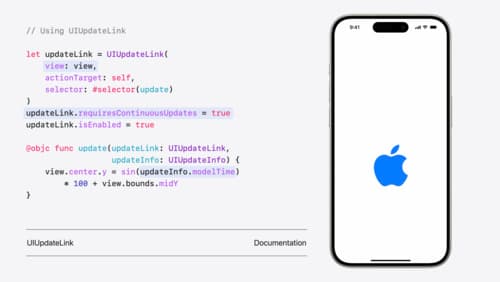what steps to use to migrate app to swift 6
Asked on 2024-08-12
1 search
To migrate your app to Swift 6, you can follow these steps as outlined in the session "Migrate your app to Swift 6" from WWDC 2024:
-
Enable Complete Concurrency Checking: Start by enabling complete concurrency checking for each module. This setting allows your project to remain in Swift 5 mode while generating warnings for code that would fail under Swift 6's enforced data isolation.
-
Resolve Warnings: Go through the warnings generated by the concurrency checking and resolve them. This step ensures that your code is ready for the stricter data isolation rules in Swift 6.
-
Enable Swift 6 Mode: Once all warnings for a target are resolved, enable Swift 6 mode. This locks in your changes and prevents future regressions to unsafe states.
-
Repeat for Each Target: Move on to the next target in your project and repeat the process.
-
Whole App Refactoring: After migrating all targets, consider doing a whole app refactoring to optimize and ensure safety across your entire codebase.
-
Adopt Concurrency Features: Optionally, adopt new concurrency features to improve responsiveness and performance, ensuring that these changes do not introduce new data races.
For more detailed guidance, you can refer to the session Migrate your app to Swift 6 (07:26) which covers the strategy for migration.
Relevant Sessions
- Migrate your app to Swift 6
- What’s new in Swift (26:07) - Discusses Swift 6 language mode and data-race safety.
- Platforms State of the Union (31:22) - Covers the new Swift 6 language mode and its benefits.

What’s new in UIKit
Explore everything new in UIKit, including tab and document launch experiences, transitions, and text and input changes. We’ll also discuss better-than-ever interoperability between UIKit and SwiftUI animations and gestures, as well as general improvements throughout UIKit.

Migrate your app to Swift 6
Experience Swift 6 migration in action as we update an existing sample app. Learn how to migrate incrementally, module by module, and how the compiler helps you identify code that’s at risk of data races. Discover different techniques for ensuring clear isolation boundaries and eliminating concurrent access to shared mutable state.

What’s new in Swift
Join us for an update on Swift. We’ll briefly go through a history of Swift over the past decade, and show you how the community has grown through workgroups, expanded the package ecosystem, and increased platform support. We’ll introduce you to a new language mode that achieves data-race safety by default, and a language subset that lets you run Swift on highly constrained systems. We’ll also explore some language updates including noncopyable types, typed throws, and improved C++ interoperability.
